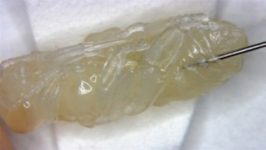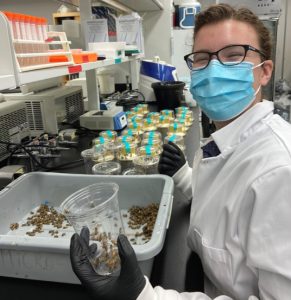Numerous viruses have been discovered in honey bees and we focus on the important deformed wing virus and Israeli acute paralysis virus. We perform experimental studies to determine the interaction between the viruses and their honey bee hosts with experimental evolution and genomic tools (QTL analysis, RNASeq). Furthermore, we study the transmission pathways of honey bee viruses across the social networks of honey bees. Beyond improving honey bee health, we seek to develop the social honey bee system as a general empirical model to study virus-host interactions in complex societies that complement individual immune mechanisms with social immunity.
 |
 |
 |
Examples:
Lu R.X., Bhatia S., Simone-Finstroem M., Rueppell O. (2023) Quantitative trait loci mapping for survival of virus infection and virus levels in honey bees. Infection, Genetics and Evolution, 116: 105534. doi:10.1016/j.meegid.2023.105534
Chapman A., Amiri E., Han B., McDermott E., Rueppell O., Tarpy D.R., Foster L.J., McAfee A. (2022) Fertility costs of cryptic viral infections in a model social insect. Scientific Reports 12:15857.
Bhatia S., Baral S.S., Vega Melendez C., Amiri E. , Rueppell O. (2021) Comparing survival of Israeli acute paralysis virus infection among stocks of U.S. honey bees. Insects, 12(1): 60.
Amiri E., Herman J.J., Strand M.K., Tarpy D.R., Rueppell O. (2020) Egg transcriptome profile responds to maternal virus infection in honey bees, Apis mellifera. Journal of Infection, Genetics and Evolution, 85:104558.
Li-Byarlay H., Boncristiani H., Howell G., Herman J., Clarke L., Strand M.K., Tarpy D.R., Rueppell O. (2020) Transcriptomic and epigenomic dynamics of honey bees in response to lethal viral infection. Frontiers in Genetics, 11:566320.
Amiri E., Strand M.K., Tarpy D.R., Rueppell O. (2020) Honey bee queens and virus infections. Viruses, 12(3): 322.
Amiri E., Kryger P., Meixner M.D., Strand M.K., Tarpy D.R., Rueppell O. (2018) Quantitative patterns of vertical transmission of deformed wing virus in honey bees. PLoS ONE, 13(3): e0195283.
